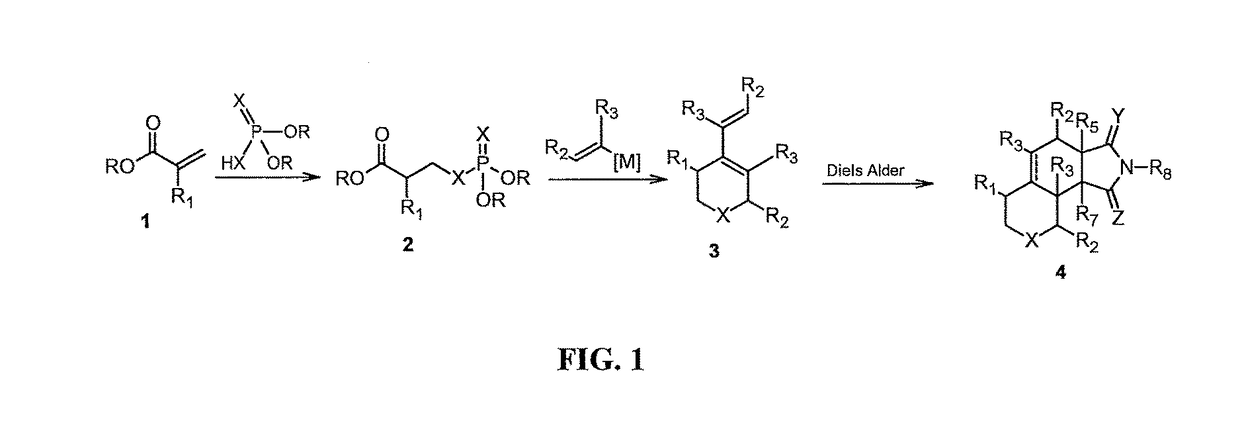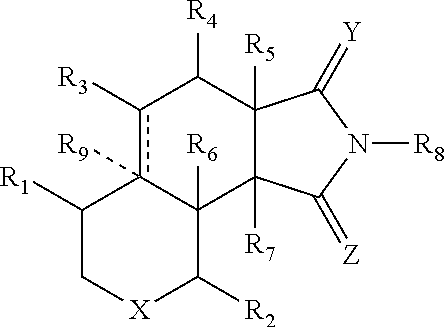Tricyclic mosquitocides and methods of making and using thereof
a technology of mosquitocides and tricyclic compounds, applied in the field of tricyclic mosquitocides and methods of making and using thereof, can solve the problems of limited spread of mosquito-borne diseases, significant risks to the population, and increased risk of mosquito-borne illnesses
- Summary
- Abstract
- Description
- Claims
- Application Information
AI Technical Summary
Benefits of technology
Problems solved by technology
Method used
Image
Examples
example 1
Synthesis of Thiopyrans Using a Sulfur-Enabled Anionic Cascade
[0138]General
[0139]Commercial reagents were purchased and used without further purification. All glassware was flame dried and reactions were performed under a nitrogen atmosphere, unless otherwise stated. Methylene chloride, tetrahydrofuran, diethyl ether and toluene were dried by passage through a solvent drying system containing cylinders of activated alumina Flash chromatography was done with Silicycle SiliaFlash® F60 silica, and thin layer chromatography (TLC) was performed with EMD 250 μm silica gel 60-F254 plates. 1H NMR spectra were acquired using Bruker (400 or 500 MHz) spectrometer with chloroform (7.26 ppm) as internal references. Signals are reported as follows: s (singlet), d (doublet), t (triplet), q (quartet), dd (doublet of doublets), dt (doublet of triplets), br s (broad singlet), m (multiplet). Coupling constants are reported in hertz (Hz). 13C NMR spectra were acquired on spectrometers operating at 100 ...
example 2
Delivery of 4-isopropyl-8-phenyl-1,3,4,6,6a,9b-hexahydrothiopyrano [3,4-e]isoindole-7,9(8H,9aH)-dione to female mosquitos
[0149]Aedes aegypti (Rockefeller strain) mosquitoes were reared in standard conditions. Four day old female mosquitoes were microinjected with 200 nL of 5% DMSO (control) or the compound described in Example 1, i.e. 4-isopropyl-8-phenyl-1,3,4,6,6a,9b-hexahydrothiopyrano [3,4-e]isoindole-7,9(8H,9aH)-dione (5.0 mM in 5% DMSO), using Nanoject II (Drummond). The injected mosquitoes were recovered for one day in the environmental chamber and fed on warmed human blood through a membrane feeder. Twenty fully fed mosquitoes from each group were observed under a dissecting microscope for defective phenotypes, including midgut and primary follicle development in the ovaries during the first gonotrophic cycle.
[0150]Evaluation of Follicle Size
[0151]The mosquitos were reared in environmental chambers. Larvae were then fed with a mixture of tropical flakes, rat chow, liver powd...
PUM
| Property | Measurement | Unit |
|---|---|---|
| size | aaaaa | aaaaa |
| size | aaaaa | aaaaa |
| size | aaaaa | aaaaa |
Abstract
Description
Claims
Application Information
 Login to View More
Login to View More - R&D
- Intellectual Property
- Life Sciences
- Materials
- Tech Scout
- Unparalleled Data Quality
- Higher Quality Content
- 60% Fewer Hallucinations
Browse by: Latest US Patents, China's latest patents, Technical Efficacy Thesaurus, Application Domain, Technology Topic, Popular Technical Reports.
© 2025 PatSnap. All rights reserved.Legal|Privacy policy|Modern Slavery Act Transparency Statement|Sitemap|About US| Contact US: help@patsnap.com



